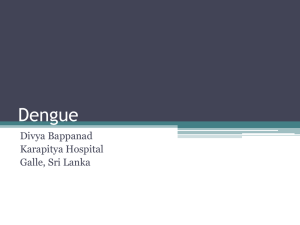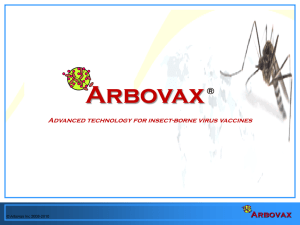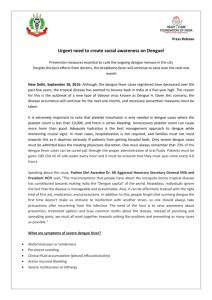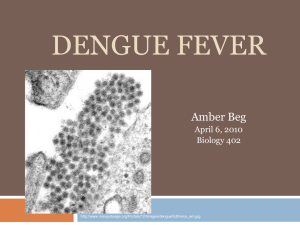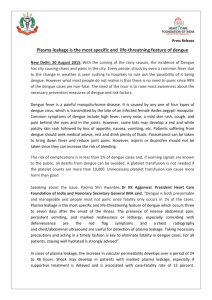a retrospective study of dengue in pregnancy
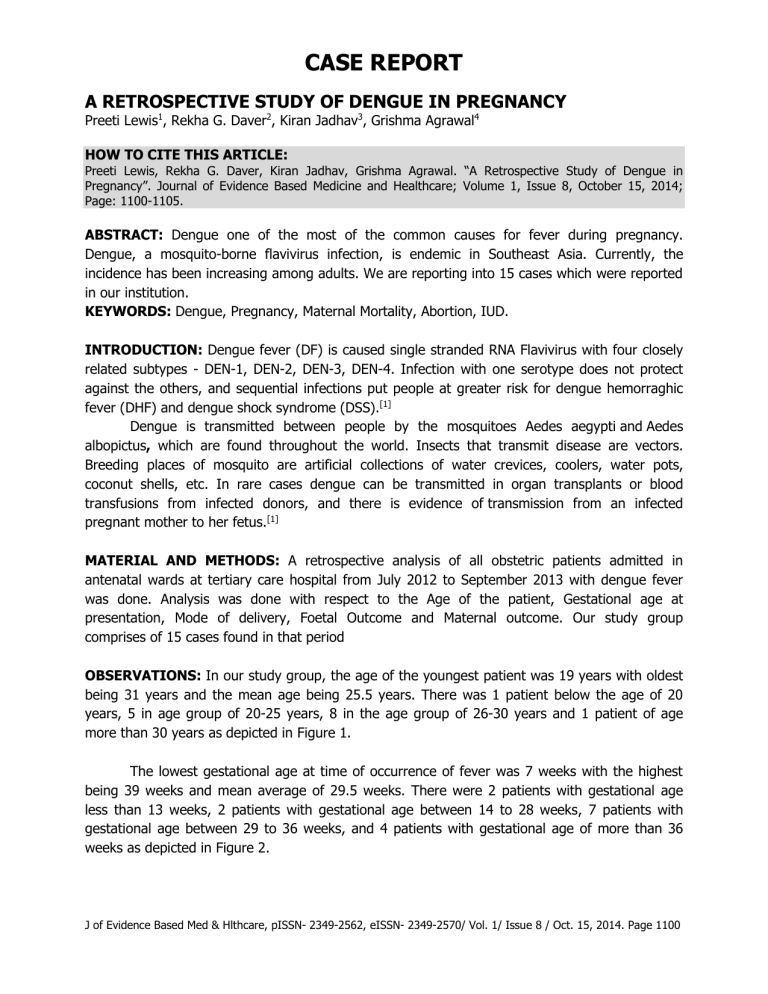
CASE REPORT
A RETROSPECTIVE STUDY OF DENGUE IN PREGNANCY
Preeti Lewis 1 , Rekha G. Daver 2 , Kiran Jadhav 3 , Grishma Agrawal 4
HOW TO CITE THIS ARTICLE:
Preeti Lewis, Rekha G. Daver, Kiran Jadhav, Grishma Agrawal. “A Retrospective Study of Dengue in
Pregnancy”. Journal of Evidence Based Medicine and Healthcare; Volume 1, Issue 8, October 15, 2014;
Page: 1100-1105.
ABSTRACT: Dengue one of the most of the common causes for fever during pregnancy.
Dengue, a mosquito-borne flavivirus infection, is endemic in Southeast Asia. Currently, the incidence has been increasing among adults. We are reporting into 15 cases which were reported in our institution.
KEYWORDS: Dengue, Pregnancy, Maternal Mortality, Abortion, IUD.
INTRODUCTION: Dengue fever (DF) is caused single stranded RNA Flavivirus with four closely related subtypes - DEN-1, DEN-2, DEN-3, DEN-4. Infection with one serotype does not protect against the others, and sequential infections put people at greater risk for dengue hemorraghic fever (DHF) and dengue shock syndrome (DSS).
[1]
Dengue is transmitted between people by the mosquitoes Aedes aegypti and Aedes albopictus, which are found throughout the world. Insects that transmit disease are vectors.
Breeding places of mosquito are artificial collections of water crevices, coolers, water pots, coconut shells, etc. In rare cases dengue can be transmitted in organ transplants or blood transfusions from infected donors, and there is evidence of transmission from an infected pregnant mother to her fetus.
[1]
MATERIAL AND METHODS: A retrospective analysis of all obstetric patients admitted in antenatal wards at tertiary care hospital from July 2012 to September 2013 with dengue fever was done. Analysis was done with respect to the Age of the patient, Gestational age at presentation, Mode of delivery, Foetal Outcome and Maternal outcome. Our study group comprises of 15 cases found in that period
OBSERVATIONS: In our study group, the age of the youngest patient was 19 years with oldest being 31 years and the mean age being 25.5 years. There was 1 patient below the age of 20 years, 5 in age group of 20-25 years, 8 in the age group of 26-30 years and 1 patient of age more than 30 years as depicted in Figure 1.
The lowest gestational age at time of occurrence of fever was 7 weeks with the highest being 39 weeks and mean average of 29.5 weeks. There were 2 patients with gestational age less than 13 weeks, 2 patients with gestational age between 14 to 28 weeks, 7 patients with gestational age between 29 to 36 weeks, and 4 patients with gestational age of more than 36 weeks as depicted in Figure 2.
J of Evidence Based Med & Hlthcare, pISSN- 2349-2562, eISSN- 2349-2570/ Vol. 1/ Issue 8 / Oct. 15, 2014. Page 1100
CASE REPORT
In this group, 2 patients aborted spontaneously, 2 had preterm vaginal delivery, 8 reached term pregnancy out of which 6 delivered vaginally and 2 underwent C-Section and 3 were lost to Follow-up as depicted in Figure 3.
A special mention on a case of maternal mortality, referred as a case Primigravida with full term gestation with dengue with Plasmodium Vivax with Thrombocytopenia (24,000). Patient was admitted for 6 days, given IV antibiotics and 6 units of platelets and kept in ICU in Apex multispecialty hospital, Sakinaka, Mumbai, from where she was referred to our institute. On admission platelet count was 29,000 and total 12 units of platelets were infused. She delivered FSB of 2.6 kg on day 4 of admission, in MICU. Post-delivery she developed Left sided Facial weakness with difficulty in speech that was followed by high grade fever with altered sensorium. On further investigating, patient was diagnosed as having post infectious Acute Demyelinating encephalomyelitis (ADEM) with ARF but she expired due to aspiration pneumonia with acute onset pulmonary haemorrhage.
DISCUSSION: Symptoms of infection usually begin 4-7 days after the mosquito bite and typically last 3 - 10 days. In order for transmission to occur the mosquito must feed on a person during a 5- day period when large amounts of virus are in the blood; this period usually begins a little before the person become symptomatic. After entering the mosquito in the blood meal, the virus will require an additional 8-12 days incubation before it can then be transmitted to another human. The mosquito remains infected for the remainder of its life, which might be days or a few weeks.
[1]
Classification: The traditional WHO classification (1997) is defined as follows: Dengue Fever
(DF), Dengue Hemorrhagic Fever (DHF), and Dengue Shock Syndrome (DSS) but the new WHO classification (2009) for dengue severity is divided into Dengue without Warning Signs, Dengue with Warning Signs, and Severe Dengue.
Dengue without Warning Signs- It includes Fever and two of the following: Nausea, vomiting, Rash, Aches and pains, Leukopenia, Positive tourniquet test.
Dengue with Warning Signs- It is defined if patient has any of the following features:
Abdominal pain or tenderness, persistent vomiting, clinical fluid accumulation (ascites, pleural effusion), mucosal bleeding, lethargy, restlessness, liver enlargement >2 cm.
Laboratory: Increase in HCT concurrent with rapid decrease in platelet count.
Severe Dengue: Dengue with at least one of the following criteria-Severe plasma leakage leading to: shock (DSS) and fluid accumulation with respiratory distress, severe bleeding as evaluated by clinician, severe organ involvement like liver: AST or ALT ≥1000, CNS: impaired consciousness, failure of heart and other organs [2]
J of Evidence Based Med & Hlthcare, pISSN- 2349-2562, eISSN- 2349-2570/ Vol. 1/ Issue 8 / Oct. 15, 2014. Page 1101
CASE REPORT
Diagnostic Investigations: The current methods used for diagnosis include-Virus isolation by cell culture, Nucleic acid detection, RT-PCR, Real-time RT-PCR, Isothermal amplification methods,
Detection of antigens, Serological tests like MAC-Elisa, IgA, IgM/IgG ratio, Haemagglutinationinhibition test.
In our institute test used for detection of dengue virus is Ig M antibody-capture enzymelinked immunosorbent assay (ELISA). Dengue-specific antigens, from one to four serotypes (DEN-
1, -2, -3, and -4), are bound to the captured anti-dengue Ig M antibodies and are detected by monoclonal or polyclonal dengue antibodies directly or indirectly conjugated with an enzyme that will transform a non-coloured substrate into coloured products. The optical density is measured by spectrophotometer.
Ig M levels peak about two weeks after the onset of symptoms and then decline generally to undetectable levels over 2–3 months. Anti-dengue serum Ig G is generally detectable at low titers at the end of the first week of illness, increasing slowly thereafter, with serum Ig G still detectable after several months, and probably even for life.
[3-5]
Management: The management of dengue fever should be prompt and aggressive. Pt is started on parentral fluids and broad spectrum antibiotics along with symptomatic treatment. Blood transfusions and platelet therapy may be required if there is thrombocytopenia with hemoconcentration. Monitoring of maternal and foetal parameters, serum electrolytes and blood coagulation profile is necessary.
Our study results at the end proved that Dengue fever has adverse effects on both maternal and fetal health. Adverse effects on the foetal health include Missed abortion, VLBW,
Still Birth, and IUGR. Adverse effects on the maternal health include Preterm Delivery, Wound gape and in extreme cases, maternal mortality. It has been observed that lesser the age of gestation at the time of infection, less favorable outcome for the baby and more favorable outcome for the mother.
In our study total 15 obstetric patients having Dengue infection were observed. Case no 1 and 2 had dengue infection in first trimester, resulting in missed abortion and had to undergo suction evacuation operation, suggesting dengue infection in first trimester could possibly have adverse effect on pregnancy. Case no. 3 had dengue infection at 26 weeks i.e. 2 nd trimester, resulting in preterm delivery at 28 weeks. Baby was admitted in NICU for 2 months for LBW and was discharged at 1.8 kg. Mother had thrombocytopenia up to 59,000. But the patient responded to conservative management without any need of platelet transfusion. It also underlines necessity of having efficient NICU. Case no. 4 and 5 had dengue infection at 28 and 30 weeks, both happened to deliver vaginally only to deliver IUGR babies of 2.1 kg and 2.2 kg respectively.
Case no. 6 had dengue infection at 31 weeks and patient delivered a still birth baby at 32 weeks vaginally. Patient was also found to have thrombocytopenia but again managed conservatively. Case no. 7 had dengue at 32 weeks leading up to delivery of a IUGR baby of 2 kg, by emergency LSCS in view of Meconium stained amniotic fluid. Cases no 9 to 12 had infection after 36 weeks of gestation, all carrying their pregnancy up to term and delivered healthy babies ranging from 2.6 kg to 3.1 kg. Above cases may point to the fact that dengue infection accrued in
J of Evidence Based Med & Hlthcare, pISSN- 2349-2562, eISSN- 2349-2570/ Vol. 1/ Issue 8 / Oct. 15, 2014. Page 1102
CASE REPORT
1 st and 2 nd trimester indeed have adverse effect on pregnancy and in later months of gestation i.e. after 36 weeks seems to have little effect on outcome of pregnancy.
[6]
A study of 38 cases by Carles G et al in French Guiana showed that In case of dengue fever infection of the mother during pregnancy, there is a serious risk of premature birth and fetal death. In case of infection close to term, there is a risk of hemorrhage for both the mother and the newborn. The major consequences for the mothers were risk of premature delivery in 55% of the cases, one case of severe hemorrhagic complications during a cesarean section, and one case of abruptio placentae. The consequences for the fetus were premature birth in 22% of the cases,
5 in utero fetal deaths, 4 cases of acute fetal distress during labor and 2 cases of mother-to-child transmission.
[7] In our study, 2 had spontaneous abortions, premature births were 2, 6 had FTND, and 2 pregnancies terminated in LSCS.
A case series on dengue fever in pregnancy done in Maternity hospital Srilanka done by
Waduge R, et al over a period of 4 years studied 26 cases with {mean (S.D.) age: 29(4.2) years}.
One (3.8%), 2 (7.7%) and 20 (77%) presented in the first, second and third trimesters of pregnancy, and 3 (11.5%) in the immediate post-partum period.
[8] In our study, the mean age was 25.5 years and 2 (13%) patients presented in First trimester, 2(13%) in Second trimester, and 11 (74%) in third trimester.
Seven (26.9%) needed admission to an ICU as compared to 1 patient in our study, Raised
AST and ALT levels were seen in 81.2% and 43.7% of 16 patients in whom liver function tests results were available.
CONCLUSION: Every case of fever in pregnancy should be investigated for Dengue. Dengue fever does have adverse effect on pregnancy outcome especially if it occurs in early weeks of pregnancy. Early reporting and early diagnosis help in improving the outcome of pregnancy.
J of Evidence Based Med & Hlthcare, pISSN- 2349-2562, eISSN- 2349-2570/ Vol. 1/ Issue 8 / Oct. 15, 2014. Page 1103
CASE REPORT
REFERENCES:
1.
Centers for Disease Control and Prevention. "Dengue." Epidemiology (2010).
2.
World Health Organization. Geneva, Switzerland: WHO; 2010. Working to Overcome the
Global Impact of Neglected Tropical Diseases. First WHO report on Neglected Tropical
Diseases.
3.
Innis B, et al. An enzyme-linked immunosorbent assay to characterize dengue infections where dengue and Japanese encephalitis co-circulate. American Journal of Tropical Medicine and Hygiene. 1989; 40: 418–427. [PubMed]
4.
PAHO. Dengue and dengue hemorrhagic fever in the Americas: guidelines for prevention and control. Washington, DC: Pan American Health Organization; 1994. (Scientific
Publication No. 548)
5.
WHO. Dengue haemorrhagic fever: diagnosis, treatment, prevention and control. 2nd ed.
Geneva: World Health Organization; 1997.
J of Evidence Based Med & Hlthcare, pISSN- 2349-2562, eISSN- 2349-2570/ Vol. 1/ Issue 8 / Oct. 15, 2014. Page 1104
CASE REPORT
6.
Maternal and fetal outcome of dengue fever in pregnancy T.V. Chitra & Seetha Panicker,
Department of Obstetrics & Gynaecology, P.S.G. Institute of Medical Sciences & Research,
Coimbatore, India
7.
Carles G 1 , Talarmin A, Peneau C, Bertsch M: [Dengue fever and pregnancy. A study of 38 cases in french Guiana] J Gynecol Obstet Biol Reprod (Paris). 2000 Dec ; 29(8) : 758-762.
8.
Waduge R 1 , Malavige GN, Pradeepan M, Wijeyaratne CN, Fernando S, Seneviratne SL.:
[Dengue infections during pregnancy: a case series from Sri Lanka and review of the literature.] J Clin Virol. 2006 Sep; 37(1): 27-33. Epub 2006 Jul 13.
AUTHORS:
1.
Preeti Lewis
2.
Rekha G. Daver
3.
Kiran Jadhav
4.
Grishma Agrawal
PARTICULARS OF CONTRIBUTORS:
1.
Assistant Professor, Department of
Obstetrics and Gynaecology, Grant
Government Medical College and Sir J. J.
Group of Hospitals.
2.
Professor and HOD, Department of
Obstetrics and Gynaecology, Grant
3.
Government Medical College and Sir J. J.
Group of Hospitals.
Resident, Department of Obstetrics and
Gynaecology, Grant Government Medical
College and Sir J. J. Group of Hospitals.
4.
Resident, Department of Obstetrics and
Gynaecology, Grant Government Medical
College and Sir J. J. Group of Hospitals.
NAME ADDRESS EMAIL ID OF THE
CORRESPONDING AUTHOR:
Dr. Preeti Lewis,
5/10, Panchsheel Building,
J. J. Hospital Campus, Byculla,
Mumbai – 8.
E-mail: plewisin@gmail.com
Date of Submission: 26/08/2014.
Date of Peer Review: 27/08/2014.
Date of Acceptance: 19/09/2014.
Date of Publishing: 15/10/2014.
J of Evidence Based Med & Hlthcare, pISSN- 2349-2562, eISSN- 2349-2570/ Vol. 1/ Issue 8 / Oct. 15, 2014. Page 1105

